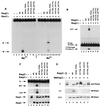Mutations in conserved regions of the predicted RAG2 kelch repeats block initiation of V(D)J recombination and result in primary immunodeficiencies
- PMID: 10891502
- PMCID: PMC86034
- DOI: 10.1128/MCB.20.15.5653-5664.2000
Mutations in conserved regions of the predicted RAG2 kelch repeats block initiation of V(D)J recombination and result in primary immunodeficiencies
Abstract
The V(D)J recombination reaction is composed of multiple nucleolytic processing steps mediated by the recombination-activating proteins RAG1 and RAG2. Sequence analysis has suggested that RAG2 contains six kelch repeat motifs that are predicted to form a six-bladed beta-propeller structure, with the second beta-strand of each repeat demonstrating marked conservation both within and between kelch repeat-containing proteins. Here we demonstrate that mutations G95R and DeltaI273 within the predicted second beta-strand of repeats 2 and 5 of RAG2 lead to immunodeficiency in patients P1 and P2. Green fluorescent protein fusions with the mutant proteins reveal appropriate localization to the nucleus. However, both mutations reduce the capacity of RAG2 to interact with RAG1 and block recombination signal cleavage, therefore implicating a defect in the early steps of the recombination reaction as the basis of the clinical phenotype. The present experiments, performed with an extensive panel of site-directed mutations within each of the six kelch motifs, further support the critical role of both hydrophobic and glycine-rich regions within the second beta-strand for RAG1-RAG2 interaction and recombination signal recognition and cleavage. In contrast, multiple mutations within the variable-loop regions of the kelch repeats had either mild or no effects on RAG1-RAG2 interaction and hence on the ability to mediate recombination. In all, the data demonstrate a critical role of the RAG2 kelch repeats for V(D)J recombination and highlight the importance of the conserved elements of the kelch motif.
Figures







Similar articles
-
The V(D)J recombination activating protein RAG2 consists of a six-bladed propeller and a PHD fingerlike domain, as revealed by sequence analysis.Cell Mol Life Sci. 1998 Aug;54(8):880-91. doi: 10.1007/s000180050216. Cell Mol Life Sci. 1998. PMID: 9760994 Free PMC article.
-
Definition of minimal domains of interaction within the recombination-activating genes 1 and 2 recombinase complex.J Immunol. 2000 Jun 1;164(11):5826-32. doi: 10.4049/jimmunol.164.11.5826. J Immunol. 2000. PMID: 10820261
-
Identification of basic residues in RAG2 critical for DNA binding by the RAG1-RAG2 complex.Mol Cell. 2001 Oct;8(4):899-910. doi: 10.1016/s1097-2765(01)00352-5. Mol Cell. 2001. PMID: 11684024
-
New insights into the evolutionary origins of the recombination-activating gene proteins and V(D)J recombination.FEBS J. 2017 Jun;284(11):1590-1605. doi: 10.1111/febs.13990. Epub 2017 Jan 6. FEBS J. 2017. PMID: 27973733 Free PMC article. Review.
-
The roles of the RAG1 and RAG2 "non-core" regions in V(D)J recombination and lymphocyte development.Arch Immunol Ther Exp (Warsz). 2009 Mar-Apr;57(2):105-16. doi: 10.1007/s00005-009-0011-3. Epub 2009 Mar 31. Arch Immunol Ther Exp (Warsz). 2009. PMID: 19333736 Review.
Cited by
-
An interdomain boundary in RAG1 facilitates cooperative binding to RAG2 in formation of the V(D)J recombinase complex.Protein Sci. 2015 May;24(5):861-73. doi: 10.1002/pro.2660. Epub 2015 Apr 2. Protein Sci. 2015. PMID: 25676158 Free PMC article.
-
Lack of iNKT cells in patients with combined immune deficiency due to hypomorphic RAG mutations.Blood. 2008 Jan 1;111(1):271-4. doi: 10.1182/blood-2007-06-096487. Epub 2007 Sep 21. Blood. 2008. PMID: 17890453 Free PMC article.
-
Mapping and Quantitation of the Interaction between the Recombination Activating Gene Proteins RAG1 and RAG2.J Biol Chem. 2015 May 8;290(19):11802-17. doi: 10.1074/jbc.M115.638627. Epub 2015 Mar 5. J Biol Chem. 2015. PMID: 25745109 Free PMC article.
-
Programmed DNA breaks in lymphoid cells: repair mechanisms and consequences in human disease.Immunology. 2016 Jan;147(1):11-20. doi: 10.1111/imm.12547. Epub 2015 Nov 18. Immunology. 2016. PMID: 26455503 Free PMC article. Review.
-
RAG gene defects at the verge of immunodeficiency and immune dysregulation.Immunol Rev. 2019 Jan;287(1):73-90. doi: 10.1111/imr.12713. Immunol Rev. 2019. PMID: 30565244 Free PMC article. Review.
References
-
- Adams J, Kelso R, Cooley L. The kelch repeat superfamily of proteins: propellers of cell function. Trends Cell Biol. 2000;10:17–24. - PubMed
-
- Agrawal A, Eastman Q M, Schatz D G. Transposition mediated by RAG1 and RAG2 and its implications for the evolution of the immune system. Nature. 1998;394:744–751. - PubMed
-
- Aidinis V, Dias D C, Gomez C A, Bhattacharyya D, Spanopoulou E, Santagata S. Definition of minimal domains of interaction within the recombination-activating genes 1 and 2 recombinase complex. J Immunol. 2000;164:5826–5832. - PubMed
Publication types
MeSH terms
Substances
Grants and funding
LinkOut - more resources
Full Text Sources
